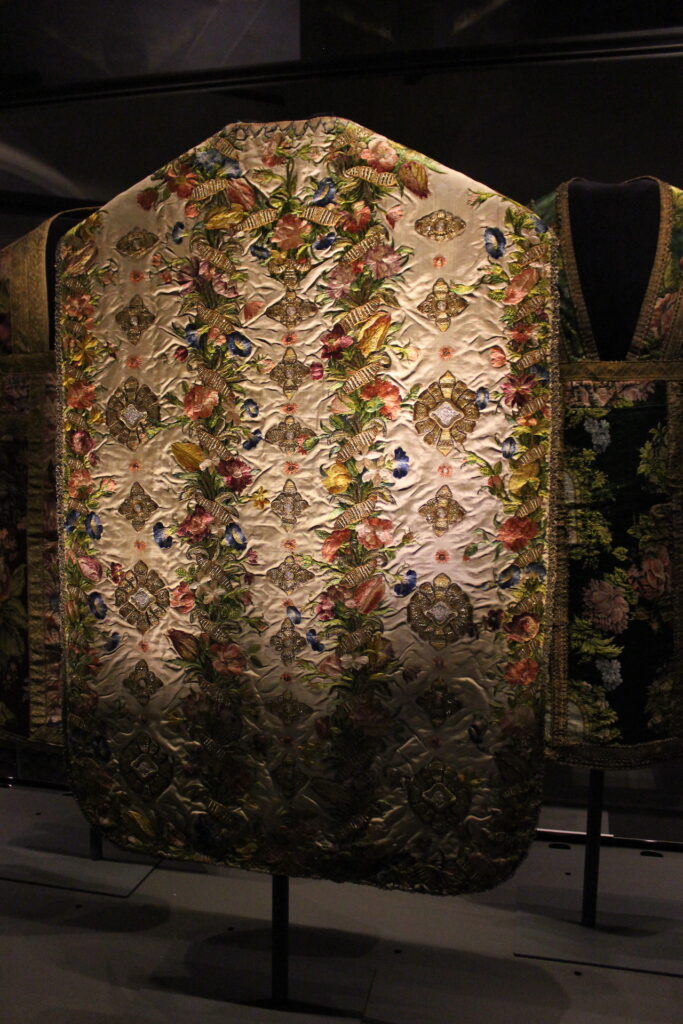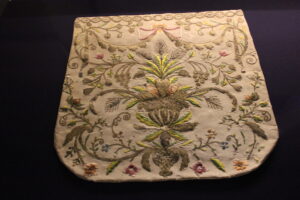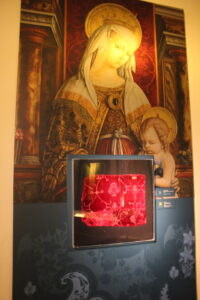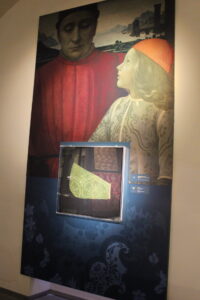A extraordinary embroidered cope in the Tesori di Seta exhibition
“Ottavia in a brocade dress” by Beatrice Brandini
On the occasion of the 50th anniversary of the Prato Textile Museum, an exhibition of European fabrics from the 15th to the 18th century celebrates the extraordinary and very generous donation of Giovanni Falletti, consisting of over 2,000 objects including fabrics, prints, books, accessories, ritual masks and historical weapons.
Liturgical embroidery, Sicily, 18th century
Embroidered panel Tesori di Seta
The exhibition, which will be open to the public from today, December 20, 2024, until December 21, 2025, and curated by Daniela Degl’Innocenti, enriches the already inestimable heritage of the Textile Museum with its sixty works from the collection of the Florentine doctor Giovanni Falletti.
A extraordinary embroidered cope in the Tesori di Seta exhibition
A wonderful embroidered velvet panel in the Tesori di Seta exhibition
For the first time we will be able to admire ancient textile artifacts and embroideries that represent the initial nucleus from which Falletti started his collection. As the collector himself admitted in the press conference, it was a sort of lightning bolt, but I prefer to define it as a love affair, which led him to purchase an object (the first a green velvet cope [liturgical garment] from the 15th century), to then study it, understand it, and deepen his knowledge also through other acquisitions.
A multimedia image in the Tesori di Seta exhibition
To facilitate the understanding of historical and technical contents, the exhibition hall is equipped with two multimedia devices that tell the story of the fabric manufacturing process and the development of the art of silk up to the pre-industrial period.
Other wonderful copes in the Tesori di Seta exhibition
For the 15th century, the velvets on display represent the absolute excellence of the major Italian manufacturing centers. Among the most common designs is the lobed leaf that includes the pomegranate motif. In the seventeenth century, Italian textile manufacturers are characterized by a varied offer of products and designs, influenced by the artistic contamination of oriental fabrics. In the eighteenth century, painting and textile design are two sectors that join together and eighteenth-century French painters such as Antoine Watteau, François Boucher, Charles Le Brun… often dedicate themselves to the decorative arts as well.
An embroidered cope
I found Giovanni Falletti to be a true gentleman, extremely lucid, but also kind and sagacious, and I share, as I have written many times, his incredulity in understanding why Florence has not yet dedicated a museum to ancient fabrics. Why Italian fabrics have been ignored by the rest of the world for many centuries, why many of the beautiful things that are part of our artistic heritage, such as ancient and modern fashion, are found in dungeons or cellars of historic buildings, and are not admired by the public.
A moment from the press conference in which we see the President of the Textile Museum Foundation Fabia Romagnoli
Italy is a nation with an extraordinary history that we can admire simply by looking around, but unfortunately we often do not know how to enhance it, nor capitalize on it. It happens, for example, that abroad a museum survives thanks to a single important work.
A multimedia image in the Tesori di Seta exhibition
The Prato Textile Museum is a great one, both for the wealth of ancient and contemporary fabrics, embroidered artifacts, samples, sketches, which it offers to its public, qualifying itself as the largest cultural centre in Italy dedicated to the valorization of ancient and contemporary textile art and production. Both for the variety and beauty of the exhibitions it offers and which touch on very different artists and subjects, always very interesting (Ferré with his white shirts, the Kimonos, Turandot, Walter Albini, just to name a few).
The cake that celebrates the first fifty years of the Textile Museum which will be celebrated in 2025
During the press conference a celebratory cake arrived, in 2025, in fact, the Museum will celebrate its first fifty years; it is a beautiful milestone but it will certainly be only the beginning of a journey that will be increasingly beautiful and exciting. Best wishes Museo del Tessuto di Prato!
Good life to everyone!
Beatrice














